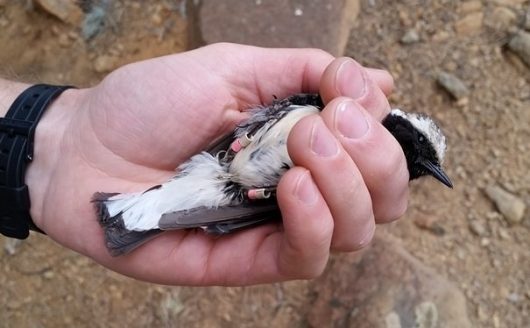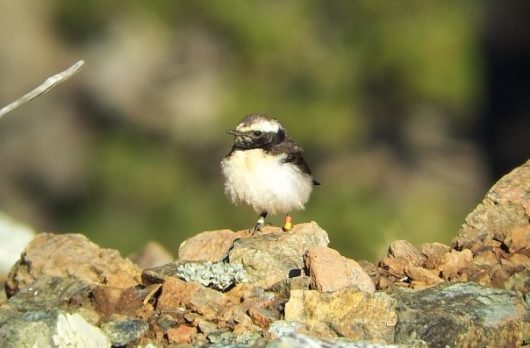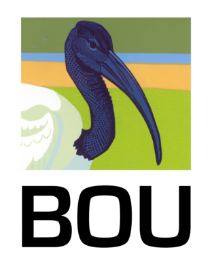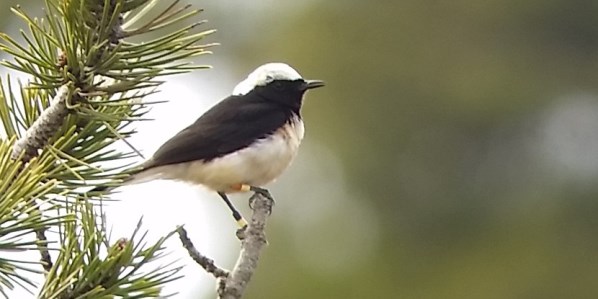To track small birds you need to catch them; twice…
LINKED PAPER
Cyprus Wheatears Oenanthe cypriaca likely reach sub-Saharan African wintering grounds in a single migratory flight. Xenophontos, M., Blackburn, E. & Cresswell, W. 2017. Journal of Avian Biology. DOI: 10.1111/jav.01119 VIEW
The success of any geolocator study rests on the ability to recatch the tagged bird. If you can’t get your tag back with all its location data for you to download, then there are no data. And to do that you need to recatch the same individual you tagged, one year or so later. That’s obvious, yet the fascination with the whole process of tagging seems to revolve around the tag design, its weight, its attachment to the bird, its technical capacity and so on, yet the real craft and skill of the study – catching and re-catching the same bird – is often neglected.

We have been tagging Cyprus Wheatears, Oenanthe cypriaca, in the Troodos Mountains of Cyprus: a pilot study in 2014-15 to get proof of principle and now a much larger intensive study involving hundreds of geolocators fitted to adult and juvenile birds, with our primary aim to look at the development of migration with age. So we need to catch and recatch hundreds of birds. And when we track a juvenile again as an adult, then we will need to catch that individual at least three separate times. It’s a daunting task, particularly because the limiting factor in the pilot study was our ability to recatch the returning birds, not their survival or lack of return.

© Will Cresswell
Of 24 birds tagged, 14 returned (58%) – a great survival rate for a small trans-Saharan migrant and more or less exactly the same as our control group of 81 colour-ringed only birds. But then we were only able to recatch 6 of them. A success in terms of finding out the wintering range of the species (South Sudan to Eritrea), their winter movements (or not) and their ability to get from Cyprus to their wintering ground in a single flight. But a failure in terms of a sample size of 6 only – when there were another 8 to be had, if we could only recapture them. This failure has focused us on the real challenge of geolocator studies – the recapture. And this is, of course, old school ornithology: the art of trapping.

We catch Cyprus Wheatears predominantly with spring traps. It’s a very effective method. Playback a male singing, bait your trap with a maggot, place in a territory before nest building gets started and expect to catch the male within a few minutes and the female a few minutes later. But the problem is that once caught in a spring trap, they will never take the bait again.

We have now spring trapped hundreds of Cyprus Wheatears over the 8 years of the study and we have only ever recaught two individuals in a spring trap. Some individuals in the study were trapped over 5 years ago now and they still remember how they were caught by us. A previously caught and now colour-ringed individual will happily come to look at a trap, approaching close to it, but it never goes for the maggot in the trap again (although it will happily take a free-ranging maggot). It’s admirable but so frustrating, and means we need another method to recatch the tagged bird. The obvious alternative is to mist-net, but in an often windy, montane environment covered with Berberis cretica (imagine Velcro for mistnets that will attach permanently with just one touch…), this is very difficult. Targeted mist-netting for birds visiting the nest has been our most successful approach so far, but then we need an even more basic ornithological skill – nest finding.

Hindsight is a wonderful thing when you do have the opportunity to continue a study. We are now catching our Cyprus Wheatears first with mist nets – we are less worried about who we catch then so we can site our nets to suit us. Then, the following year we have the easy option to recatch with spring traps – our best and most reliable method saved for the very high value returning birds with geolocators – and if we need to repeat tag a bird, we have the final fall-back option of catching the bird at the nest in the following year (very high effort but we will only have a small number of these very, high value birds).

So, tagging small birds sounds high-tech but actually its success is entirely to do with fundamental ornithological skills.
References
Xenophontos, M., Blackburn, E. & Cresswell, W. 2017. Cyprus Wheatears Oenanthe cypriaca likely reach sub-Saharan African wintering grounds in a single migratory flight. Journal of Avian Biology 48: 529-535. VIEW
Image credit
Featured image: Black white orange white – a male Cyprus Wheatear Oenanthe cypriaca © Will Cresswell
If you want to write about your research in #theBOUblog, then please see here.






